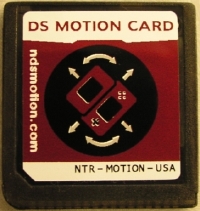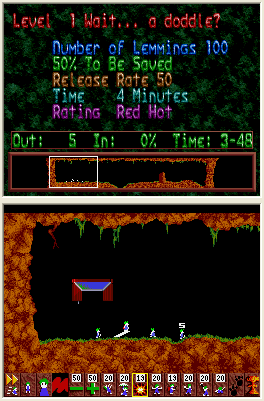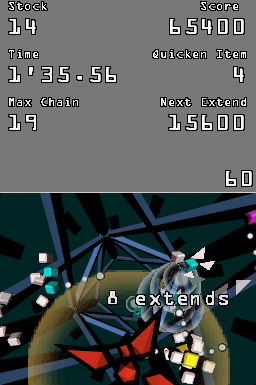DS Homebrew Review
Our new monthly look at the world of home-hacked DS hardware and software

Welcome to the first monthly Pocket Game DS Homebrew Review. Before we start, a note to newcomers – to keep up with these in future, click 'Track It!' at the bottom of the page.
If you've read our introduction to DS homebrew then you'll know that there's a wealth of free software out there that you may not be aware of. Just like our writer Simon Parkin's extraordinary special recipe stout, the homebrew scene has been maturing nicely for the last few months as the hardware used improves and gives coders more flexibility in how they use the unique features of the DS.
It is, however, a daunting task for the casual homebrew tippler to keep up with the homebrew scene. So, if you considered our starter guide as the first step out into the fresh air to help clear the headache caused by a dose of bad homebrew, then you can think of this regular feature as your monthly gym subscription to ensure you never suffer from those homebrew hangovers ever again.
Every month, we're going to show you the most interesting goings on the scene that we've come across, whether it's games, exciting new hardware, or just a handy application. So let's start!
Homebrew access hardware latest
Firstly, an update on the current state of the hardware required to run homebrew. The two major flash cartridge variations at the moment are slot-1 devices and slot-2 devices.
Slot-2 carts occupy the GBA slot, and require either a DS 'NoPass' card or a 'flashed' DS to load software. You can find out more in our guide to this type of hardware here.
The latest hardware is the slot-1 type, which is a DS-sized card and requires no additional hardware or modifications to the DS. These are much simpler to use than slot-2 devices, but as the majority of homebrew was designed for the slot-2 hardware and it's ability to boot GBA software, there are some compatibility issues. They are thankfully being ironed out, and as slot-1 devices become the standard we fully expect that all new homebrew will be designed with them in mind.
As for us, we currently use an EZ-Flash V, a slot-1 device, to try out homebrew software. It can be bought from Winsunx.
What you'll also require in some cases is the DLDI version of the software. More technically-orientated information on DLDI can be found at this page.
Wikipedia also has an excellent DS homebrew page, although it's similarly heavy going. If you require any additional information please don't hesitate to ask in our comment section below.
DS Motion – banishing your DS' Wii envy Motion sensing may be all the rage on home consoles at the moment, but that doesn't mean handheld consoles have to be left out of the gesture based hilarity. Much to our surprise, the DS has been blessed with motion sensing not by Nintendo, but by a group of home coders.
Motion sensing may be all the rage on home consoles at the moment, but that doesn't mean handheld consoles have to be left out of the gesture based hilarity. Much to our surprise, the DS has been blessed with motion sensing not by Nintendo, but by a group of home coders.
The DS Motion Card occupies the DS card slot, and can sense motion, tilt, and twist, all of which can be put to use in homebrew DS games. Our favourite implementation at the moment is DSaber, which turns the DS console into a virtual lightsaber. Vwoom.
The fact that it takes the place of the DS card in the console means that it is only compatible with slot-2 devices at the moment. However the developers are currently working on putting the same technology into a GBA cartridge, making it compatible with slot-1 carts as well.
We hope to get our hands on one of these very soon, in which case we'll give you an update on the cool things it can be used for. In the meantime more information can be found at the DS Motion Card site.
Homebrew software – this month's review
Now onto the latest homebrew software. This month we've been looking at DS versions of some classic games. Some you may already know and love, others may be new to you, but we promise that they're all well worth your time. Lemmings DS
 We've been desperate for a DS version of Lemmings for a long time. However Sony owns the rights to the franchise, and as such the chances of an official port of the game is pretty slim.
We've been desperate for a DS version of Lemmings for a long time. However Sony owns the rights to the franchise, and as such the chances of an official port of the game is pretty slim.
Luckily, those lovely homebrew coding kids have come to the rescue with an excellent – completely unofficial and unsanctioned – take on the original game.
Lemmings DS adds several new features to make stylus control as comfortable as possible, such as the ability to zoom into the level, making control over those homicidal, genocidal, suicidal, and death-defying lemmings a little easier.
Not only that, but there's a fully-featured PC level editor that enables you to create your own levels and even include your own graphics. We've already seen a level using graphics from the original Metroid, and no doubt there will be many more to come as people become more familiar with the tools.
As of writing, the original coder has released a version which is only compatible with slot-2 devices. However you can find a modified version of his release here, which can be patched to work on most slot-1 devices.
Again, we stress that this work does unfortunately infringe on Sony's copyright, so it's possible a cease and desist for the original coder will be forthcoming.
You can find out more about LemmingsDS at the Lemmings Project homepage.
Tetattds (Tetris Attack DS) Tetris Attack, originally named Panel De Pon, has been released for a variety of formats since the first version in 1995, but until now there has been no DS version. But once again homebrew comes to the rescue, producing a near-perfect, unofficial version of the original game in Tetattds, which you can download here.
Tetris Attack, originally named Panel De Pon, has been released for a variety of formats since the first version in 1995, but until now there has been no DS version. But once again homebrew comes to the rescue, producing a near-perfect, unofficial version of the original game in Tetattds, which you can download here.
The game can be controlled with the stylus, but unfortunately we personally found it to be a little too inaccurate and soon reverted back to the standard button controls.
On a brighter note, it's yet another excellent example of homebrew games being as feature laden as their commerical counterparts, including not only a single-player mode but local and online multiplayer options.
Wi-fi multiplayer is easy to set up, but requires you to have the settings already entered into the DS using an online enabled game. (See our How To guide to DS Wi-fi for further information on this.)
Flashback DS Flashback, which you may be interested to hear is the best-selling French game of all time, was originally released for the PC in 1992. Reminiscent of the original Prince of Persia games, it's a game that has aged wonderfully, thanks largely to its excellent animation and intriguing storyline.
Flashback, which you may be interested to hear is the best-selling French game of all time, was originally released for the PC in 1992. Reminiscent of the original Prince of Persia games, it's a game that has aged wonderfully, thanks largely to its excellent animation and intriguing storyline.
The port is actually of the game engine used, therefore in order to play it you will need the original files from the DOS version of the game. Luckily the game is now classed as abandonware, and as is freely available from sites such as Abandonia.
As it uses the original game code, the port is extremely faithful and works well on the DS, minor issues with cutscenes and music aside. We highly recommend that you try this one out if you haven't already, it's a true classic.
You can download the slot-1 compatible DLDI version here. And more information can be found here.
Every ExteNDS You may be familiar with Every Extend from its wonderful debut on the PSP last year as Every Extend Extra, directed by the legendary game designer Tetsuya Mizuguchi.
You may be familiar with Every Extend from its wonderful debut on the PSP last year as Every Extend Extra, directed by the legendary game designer Tetsuya Mizuguchi.
What you may not know is that it was first available as a freeware PC game.
Every ExtenDS version is virtually identical to that PC original, keeping true to the frantic but refreshing gameplay that sees you avoiding enemies and detonating your ship at the appropriate time to destroy as many as possible.
We were however disappointed that it doesn't make any use of the touch screen. Being able to control the ship with the stylus would have been an excellent addition to the game.
You can download Every ExteNDS from this page.
Tassu's gamesIt hasn't just been nostalgia trips that have interested us this month. A few titles have caught our eye from a coder named Tassu.
The first is Whee!, a 3D racing game in the style of F-Zero or WipEout. At the moment it feels like little more than a tech demo, but it demonstrates a smooth, fast game engine that could certainly be used for a fun racing game. It would benefit from multiplayer of some sort, and perhaps some more diversity in the actual race tracks. With no sign of a new F-Zero game from Nintendo, we hope that this can eventually quench our thirst for speed.
 Secondly, there's Eurotunnel. Controlled entirely by the DS touchscreen, Eurotunnel sees you flying through a variety of tunnels collecting – wait for it – euros.
Secondly, there's Eurotunnel. Controlled entirely by the DS touchscreen, Eurotunnel sees you flying through a variety of tunnels collecting – wait for it – euros.
Whilst this seems entirely pointless initially, once you've finished the level you'll notice that you've actually been drawing a picture on the touchscreen as you steer. The more accurate you were in navigating the tunnel, the better the picture will be.
Again, there isn't much to the game at the moment, but it's refreshing to see the hardware being used in a unique way, something which is sorely lacking from the majority of commercial DS games. Do check out Tassu's homepage for all his projects.
Right that's it for this month. If you have any comments or questions about anything we've featured, please feel free to ask us in the comments below.
Don't forget to click 'Track It!' to get reminded when we post out next update, and until next month – happy DS homebrew-ing!